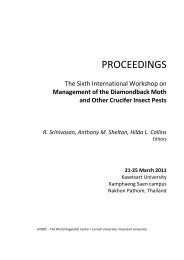Leguminous Vegetable Cultivation and Seed Production S ...
Leguminous Vegetable Cultivation and Seed Production S ...
Leguminous Vegetable Cultivation and Seed Production S ...
Create successful ePaper yourself
Turn your PDF publications into a flip-book with our unique Google optimized e-Paper software.
staking of the vines. In some places they are grown as a mixed crop with ragi, bajra or sorghum. It<br />
is planted with a distance of about 1 m between crops. The ear heads of the intercrops are<br />
harvested first leaving the stalks as support to the vines. The vines grow on them perfectly. If it is<br />
grown as a sole crop it can be sown with a distance of 2.5 x 1.5 m. Three to four seeds are sown<br />
per hill <strong>and</strong> one or two plants allowed to grow on each hill. Dwarf types can be grown at a distance<br />
of 1.0 x 0.75 m line to line <strong>and</strong> plant to plant. About 20-30 kg seed are required to sow 1 ha of<br />
bush type <strong>and</strong> 10-12 kg for climbing types.<br />
Lablab beans can be grown in a wide range of soils of average fertility. About 20 kg N,<br />
40 kg phosphorus, <strong>and</strong> 5-6 t FYM are required to grow a good crop in 1 ha of l<strong>and</strong>.<br />
Intercultivation can be done to control the weeds until vines spread between rows. Since lablab<br />
beans cannot st<strong>and</strong> waterlogging, frequent irrigations should be avoided.<br />
Ripe mature pods can be h<strong>and</strong>picked from the st<strong>and</strong>ing crop. Threshing can be done by<br />
beating the pods with a stick, moving a stone roller over the pods, or under letting bullocks trample<br />
them. <strong>Seed</strong> should be thoroughly cleaned <strong>and</strong> dried before bagging. Average seed yield is 6-<br />
8 qt/ha.<br />
Cluster Bean<br />
The tender pods are used as a vegetable <strong>and</strong> in the southern part of India they are<br />
dehydrated <strong>and</strong> stored for use. Cluster bean is a self-pollinated crop, yet some outcrossing, i.e. 2%<br />
has been reported. Thus, lesser heterosis is available. Due to less seeds in each pod, economical<br />
commercial hybrid seed production in cluster bean is not possible.<br />
<strong>Seed</strong> <strong>Production</strong> Techniques The crop should be sown in well-drained s<strong>and</strong>y loam soil.<br />
Cluster bean can also tolerate saline <strong>and</strong> moderately alkaline soils with pH ranging 7.5 to 8.0. It<br />
prefers warm climates <strong>and</strong> can also be grown in subtropical areas during summer. It prefers longday<br />
conditions for growth <strong>and</strong> short day for induction of flowering.<br />
Main a row-to-row distance of 45-60 cm <strong>and</strong> plant-to-plant spacing of 10-15 cm. <strong>Seed</strong> rate<br />
for line sowing is 15 kg/ha. To improve seed yield, 10-12 kg N, 50-70 kg P, <strong>and</strong> 50-70 kg K/ha<br />
are recommended. One or two irrigations are needed in case rains are delayed.<br />
Pull out the plants from the field after proper maturity of the pods. Keep the plants in the<br />
leap for curing <strong>and</strong> proper drying for at least one week. Threshing should be done as in the other<br />
beans. Store the seeds after proper grading <strong>and</strong> drying. The average seed yield per hectare is<br />
10 qtl.<br />
Pests of Beans<br />
a.<br />
b.<br />
c.<br />
d<br />
ė.<br />
f.<br />
g.<br />
h.<br />
J -<br />
Aphids (Aphis sp.)<br />
Jassid (Amrasca kerni)<br />
Galerucide beetle (Madurasia obscurella)<br />
Pod borer (Adisura sp. Heliothis arinigera)<br />
Bean weevil (Callosobruchus sp.)<br />
Lygacid bug (Chauliops fallax)<br />
Hairy caterpillar (Ascotis imparata)<br />
Stem fly (Ophiomyia phaseoli)<br />
Root weevil (Stiona lineal:0<br />
Bean lady bird beetle (Epilachna varivestis)<br />
6
















